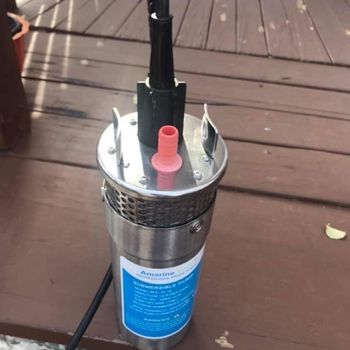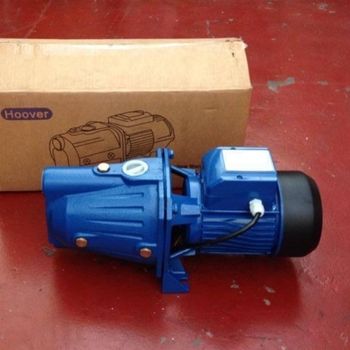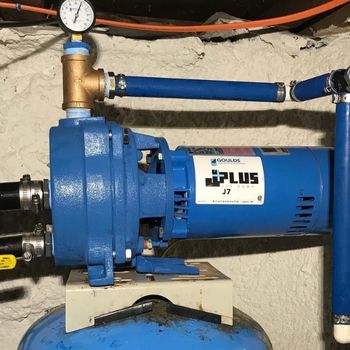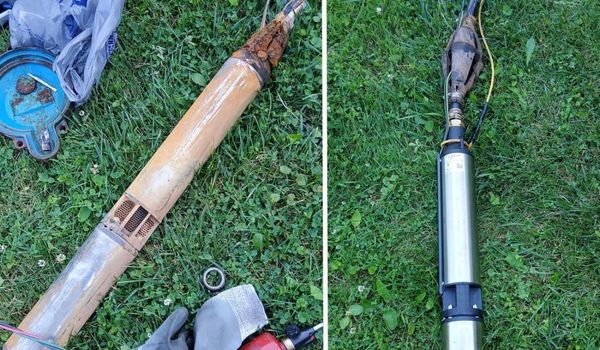A good well pump is the heart of your private water supply — but like any hardworking machine, it won’t last forever. Most pumps operate quietly in the background until something goes wrong, like sputtering water pressure or the dreaded silence when you turn on the tap.
So how long should your pump last? What makes some last 20 years and others fail after 5? And what can you do to get the most life out of yours?
Let’s get into the details — without the tech jargon.
🔑 Key Takeaways
- ⏳ Most well pumps last between 8–15 years, depending on type and usage
- 🛠️ Routine maintenance and correct system sizing extend pump life
- 💡 If your water pressure drops, your pump may need service or replacement
- ⚡ Electrical issues, sediment, and poor water chemistry can wear pumps down early
- 💦 Upgrading to high-quality parts and checking your pressure tank regularly can prevent bigger problems
- 🔍 A water test can reveal whether sediment, bacteria, or iron are harming your pump
🔍 What Is a Well Pump?

A well pump is the heart of your water system — it pulls water up from the ground and pushes it into your home. Whether you’re brushing your teeth, running a load of laundry, or watering the garden, it’s the reason you have pressure at the tap.
💡 It works by converting electric power into hydraulic energy, giving your water the muscle it needs to move.
Not all pumps work the same way though — and choosing the right one depends on your well depth, water needs, and setup.
| Type | Best For | How It Works |
|---|---|---|
| 🔧 Submersible | Deep wells (25–400+ ft) | Sits below water; pushes water upward into a pressure tank |
| 💨 Jet Pump | Shallow wells (0–25 ft) | Mounted above ground; uses suction to pull water up |
| ⚙️ Centrifugal | Low-depth or temporary systems | Uses centrifugal force; rarely used in residential homes |
🛠️ Good to know:
Submersible pumps tend to last longer and handle sediment better than jet pumps. But shallow wells are easier (and cheaper) to access when repairs are needed.
🔧Types of Well Pumps

Most residential wells rely on one of three pump types. Each works a little differently — and the best choice depends on your well depth, water table, and home setup.
🚿 1. Submersible Pumps

Submersible pumps are installed below the waterline and push water up into a pressure tank.
They’re efficient, quiet, and built for deep wells.
Key Features:
- Installed deep inside the well
- Pushes water to the surface (not suction-based)
- Low maintenance and energy-efficient
- Ideal for wells 25 to 400+ feet deep
💡 Good to Know:
A submersible pump stays submerged 24/7 — meaning it runs cooler and lasts longer than most surface pumps.
🌀 2. Jet Pumps

Jet pumps sit above ground and use suction to pull water up from the well.
They’re common for shallow wells or setups with space limitations.
Key Features:
- Surface-mounted for easy access
- Uses air pressure and suction to draw water
- Can be single-pipe (shallow) or two-pipe (deep well)
- Best for wells up to 100 feet deep
💡 Good to Know:
Jet pumps are more sensitive to air leaks and suction loss — keep the inlet sealed tight for consistent pressure.
⚙️ 3. Centrifugal Pumps

Centrifugal pumps are simple, affordable, and easy to maintain — but they’re only useful for very shallow wells.
Key Features:
- Surface pump using centrifugal force
- Minimal components = fewer breakdowns
- Only suitable for wells 25 feet deep or less
💡 Good to Know:
Because they’re so basic, centrifugal pumps are often used for irrigation or small garden wells — not full-house supply.
⏳ How Long Do Well Pumps Last?
A good well pump won’t last forever — but the right one, properly maintained, can deliver clean water for well over a decade. How long yours lasts depends on its type, how hard it works, and how well it’s cared for.
Here’s what to expect by the numbers:
| 🔧 Pump Type | ⏱️ Average Lifespan |
|---|---|
| 🔽 Submersible Pumps | 10–15 years |
| 💨 Jet Pumps | 8–12 years |
| ⚙️ Centrifugal Pumps | 6–10 years |
💡 Good to Know: Some pumps push past the 20-year mark — but only with regular inspections, the right water chemistry, and a balanced duty cycle. Treat it well, and it’ll return the favor.
🧩 What Impacts a Well Pump’s Lifespan?

A well pump doesn’t just wear out from age — everything from your water quality to system design can affect how long it lasts. Here’s what matters most:
⚡ Motor Quality
- Higher-quality motors wear down slower
- Cheap models often fail early due to poor bearings or seals
- Always choose a brand with a solid reputation — it’s worth it
🔥 Water Temperature
- Warmer climates can overheat sensitive components
- Choose pumps rated for high-heat if you live in hot regions
💧 Water Quality
- Sand, silt, and iron bacteria can clog or corrode your pump
- If your well is shallow or your screen is worn, expect more debris
- Cloudy water or orange stains could be early warning signs
⚡ Electrical Supply
- Voltage drops, power surges, or bad wiring stress the pump motor
- If your area has frequent outages, ask about surge protectors or voltage regulators
🔁 Duty Cycle
- Pumps turn on when pressure drops and stop once it’s restored
- The more water you use daily, the more your pump runs
- Activities like irrigation or filling a pool can wear it out fast
🧠 System Design
- Even a bad check valve location can shorten lifespan
- Undersized pumps or tanks = more frequent cycling
- A poor match between pump capacity and well depth causes strain
💡 Helpful to Know: Many “pump failures” aren’t actually pump issues — clogged filters, stuck pressure switches, or tank problems can trigger similar symptoms. Always inspect the full system before assuming it’s time to replace the pump.
🔧 Signs Your Well Pump Might Be Failing

Your well pump won’t suddenly stop working without dropping a few hints first. Keep an eye out for these common red flags:
⬇️ Sudden Drop in Water Pressure
If your shower starts to trickle or your faucets lose force, your pump may be struggling — or it could be a failing pressure tank or clogged screen. Systems designed for smaller households may not keep up if you’ve added a new bathroom or irrigation system.
💡 Good to Know: A spike in water demand can overwork the pump. In some cases, upgrading to a larger pump is more cost-effective than constant repairs.
🟤 Grit or Sediment in Your Water
If your tap starts spitting out sand or rust-colored debris, it may signal a damaged intake screen or a lowering water table. This kind of wear can quickly reduce your pump’s lifespan if sediment isn’t filtered out properly.
💡 Pro Tip: Adding a sediment filter or sand separator can help protect your pump from early failure.
🔁 Pump Running Constantly
Well pumps aren’t designed to run all day. If yours never shuts off, it could mean:
- A faulty pressure switch or control box
- A leak in your system
- Or your pump is no longer able to meet demand
Get it checked quickly — continuous operation is one of the fastest ways to burn out your motor.
⚡️ High Electric Bills
An aging or damaged pump often uses more power to do the same job. If your electricity bill suddenly climbs without any other explanation, your pump may be to blame.
⚖️ Pros & Cons of Well Pumps

Well pumps are the heartbeat of your private water system — but like any equipment, they come with trade-offs.
| ✅ Pros | ⚠️ Cons |
|---|---|
| Reliable Supply Consistent water pressure and access with a properly sized system. |
Maintenance Needed Pumps and pressure systems require regular inspection and upkeep. |
| Cost Savings Over Time No monthly water bill if you maintain your well system properly. |
High Upfront Cost Installation of a deep well system can be expensive initially. |
| Off-Grid Friendly Ideal for rural or remote properties without municipal access. |
Pricey Replacements Well pump replacement and labor can be costly. |
💡 Helpful Tip: If your system is aging or you’re planning upgrades, consider a well filter built for rural homes to protect your pump and extend its life.
💰 What Does It Cost to Replace a Well Pump?

Replacing a well pump isn’t cheap — but it’s a necessary investment when your system starts to fail. Total cost depends on the type of pump, well depth, and whether other components (like your pressure tank or wiring) need updating at the same time.
Here’s what to expect:
- Submersible pumps for deep wells: 💸 $500–$2,000 installed These sit below the water line and require more labor to replace.
- Jet pumps for shallow wells: 💸 $400–$1,500 installed Easier to access and often less costly.
- Additional costs may apply if your plumbing, tank, or power supply needs repair or upgrading.
💡 Good to Know:
If your pump fails due to sediment or iron buildup, it’s smart to install a filter or sand separator when replacing it. This small upgrade can prevent future damage and extend the life of your next pump.
🛠️ How to Extend the Life of a Well Water Pump

Your well pump works hard — but with the right care, it doesn’t have to wear out before its time. A little maintenance and planning can go a long way toward adding years to your pump.
Here’s what helps the most:
- ✅ Test your water first Check for iron bacteria or sediment issues before installing a new pump. This can prevent early failure and help you choose the right equipment.
- 🌀 Install a sediment filter or sand separator If your old pump was damaged by grit or debris, a centrifugal separator can trap particles before they hit your pump again.
- 🌧️ Know your water table When drilling a new well, ask your contractor about historical low water levels in your area. A deeper well can avoid dry runs and sediment-rich water.
- ⚙️ Keep your system tuned up Schedule regular inspections for your pressure switch, tank, and electrical setup. Catching small issues early prevents unnecessary wear and costly repairs later.
💡 Helpful Tip:
If your pump is pulling in grit or showing signs of overuse, take a look at your water usage habits. Running sprinklers or filling pools too often can overwork your pump — especially if it’s undersized for your household needs.
✅ Final Thoughts
A well pump isn’t something most of us think about — until the water stops flowing. But with a little attention and regular upkeep, your system can run strong for 10, 15, even 20 years.
If you’ve noticed low pressure or murky water, or your pump has just been around a while, it might be time to take a closer look. Staying ahead of wear and tear means fewer surprises down the road.
💧 Bottom line:
Treat your well pump like the hardworking tool it is — and it’ll deliver reliable water for years to come. If it’s not the pump, maybe it’s time for a new well filtration system — see our trusted choices.
 162 people found this helpful. Was this guide helpful to you?
162 people found this helpful. Was this guide helpful to you? 


